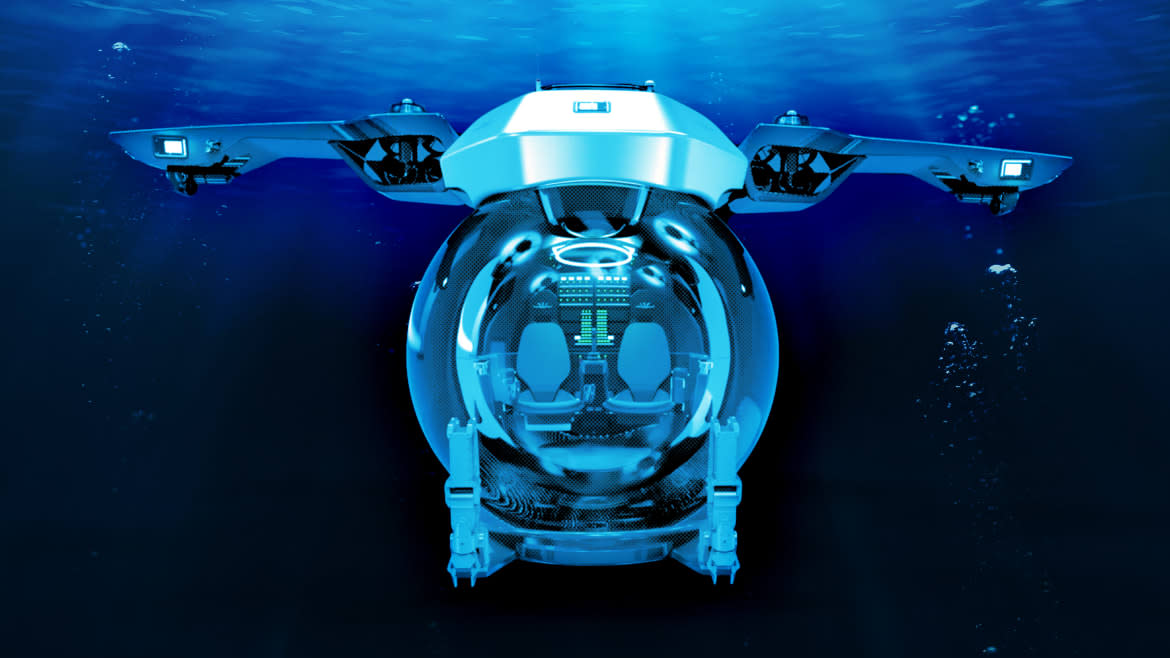A Year Post-Implosion, Some Rich Folks Still Want to Dive to the Titanic

- Oops!Something went wrong.Please try again later.
Tuesday marks a year since the Titan submersible lost contact en route to the Titanic’s wreckage site, spurning a massive rescue op and media frenzy that ended only once its horrific fate became clear—the sub had imploded, fatally crushing all five inside.
The tragedy exposed fatal flaws with the Titan’s design, OceanGate CEO Stockton’s Rush overconfidence in his calculations, and raised a popular question—is diving 12,500 feet to the bottom of the Atlantic Ocean for a glimpse of the Titanic worth risking your life over?
For most, the answer was—and remains—a resounding no. But some of the world’s uber-wealthy are still prepared to shell out millions to take a voyage to the bottom of the sea, and at least one American wants to do it, in part, simply to prove that it can safely be done.
That man is the real-estate mogul Larry Connor, of Ohio, who’s said he’s determined to not let OceanGate’s fatal failure destroy the niche submersible business entirely. He’s the same billionaire who, at 74, has already taken a sub to the Mariana Trench and has visited International Space Station.
While others with deep pockets canceled their personal submersible orders last summer with the Florida-based Triton Submarines, its co-founder, Patrick Lahey, told The Wall Street Journal that Connor called him up within days of the Titan tragedy with different plans. He said he wanted a new sub that could do what the Titan couldn’t—safely make it to the Titanic and back, repeatedly.
“I want to show people worldwide that while the ocean is extremely powerful, it can be wonderful and enjoyable and really kind of life-changing if you go about it the right way,” Connor told the Journal.

Larry Connor.
To get there, Lahey said Connor plans on loading into the the Triton 4000/2 Abyssal Explorer, which is supposedly safe to dive to a depth of approximately 13,000 feet. While its promises are similar what OceanGate once claimed about the Titan, Connor and and Lahey are emphatic that their submersible is capable of making a safe voyage to the deep. And one would think it should, considering its hefty price tag of $20 million to produce—80 times pricier than the $250,000 a ticket charged by Rush for a single Titan voyage.
The Titanic Sub Was Made Cheap—and That May Have Sealed Its Fate
A spokesperson for Triton told CNN on Tuesday that its Titanic voyage remains in the early planning stages, and that a timeline isn’t available. The company did not respond to questions sent by The Daily Beast asking about its capacity and whether tickets would be available for purchase.
Triton has emphasized it operates with much higher standards than OceanGate, which folded days after its founder died alongside a Pakistani millionaire, his teenage son, an airline executive, and a world-famous oceanographer a year ago. The submersibles listed on its website appear much more comfortable than that of the Titan, with many boasting panoramic windows and proper seats—a far cry from the infamously cold and crowded Titan, which was controlled by an Xbox controller.
Adding to Lahey’s credibility is a long list of receipts that displays just how long he considered Rush and OceanGate to be dangerous players in the world of submersibles. He joined others, including Rob McCallum, founder of the ultra-high-end expedition company Eyos, in expressing their concern.
In 2018, McCallum emailed Rush to skewer him for pushing through with trips to the Titanic with un-classed technology.
“You are wanting to use a prototype un-classed technology in a very hostile place,” McCallum wrote to Rush, according to the BBC. “As much as I appreciate entrepreneurship and innovation, you are potentially putting an entire industry at risk.”
After the Titan imploded, Lahey was equally critical of OceanGate. In an interview with The Sunday Times, he called Rush “predatory.” More recently, he told the Journal that OceanGate’s issues were self-inflicted, and not because submersibles themselves are inherently dangerous.
“This tragedy had a chilling effect on people’s interest in these vehicles,” Lahey told the Journal. “It reignited old myths that only a crazy person would dive in one of these things.”
For one, Lahey said the Triton 4000/2 Abyssal Explorer is made mainly of acrylic, and has been “classed” by third-party maritime-classification societies. The Titan was infamously unclassed.
While Connor has shown a willingness to dump millions into returning dives to the Titanic wreckage site, more casual submersible fans appear to have become more hesitant in the wake of the Titan disaster.
Officials at Triton’s biggest competitor, U-Boat Worx, have laid off of 40 of its 85 employees since the implosion, reportedly brought on by a significant drop in interest in submersibles for personal use.
Chilling Tales of Past Dives to Titanic Wreckage Keep Piling Up
Possibly adding to the uneasiness from potential buyers is the unknown surrounding what exactly caused the Titan to implode. While many speculate the accident was brought on by a crack in its carbon fiber, an official investigation by the U.S. Coast Guard remained ongoing as of Tuesday, a spokesperson told The Daily Beast.
“The investigation into the implosion of the Titan submersible is a complex and ongoing effort,” the Coast Guard said in a statement. “We are working closely with our domestic and international partners to ensure a comprehensive understanding of the incident.”
Guardsman initially said they’d need just a year to complete their probe, but said Tuesday that there have been “necessary delays” because of the complications around salvaging evidence from the implosion site in the middle of the northern Atlantic Ocean.
The Coast Guard said Tuesday it plans to “hold a public hearing session by the end of the year,” with notice given two months in advance.
Get the Daily Beast's biggest scoops and scandals delivered right to your inbox. Sign up now.
Stay informed and gain unlimited access to the Daily Beast's unmatched reporting. Subscribe now.

